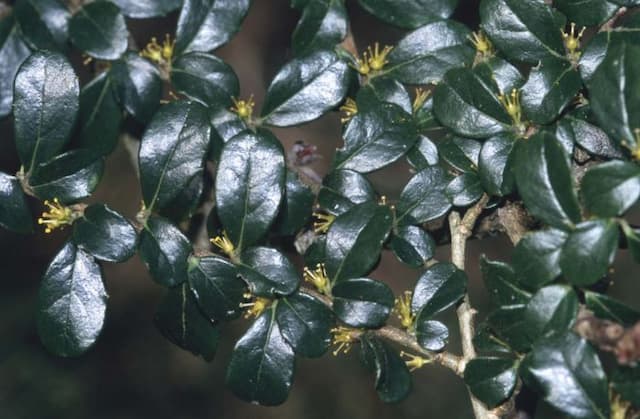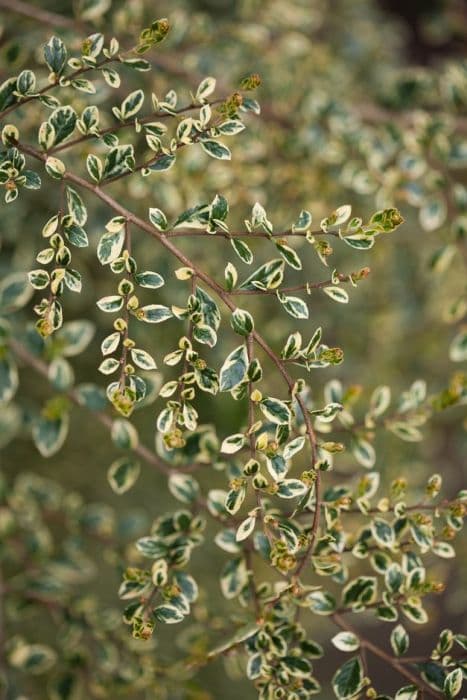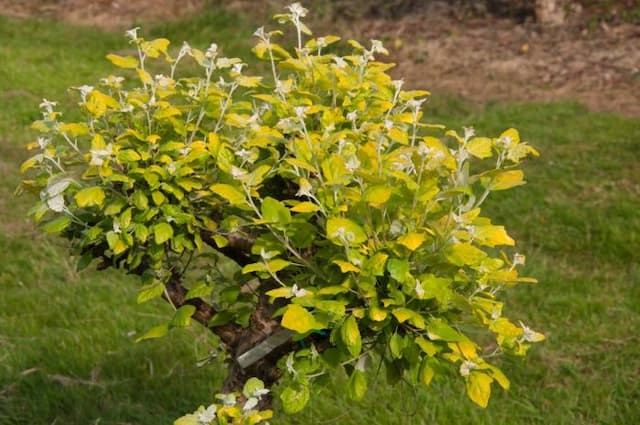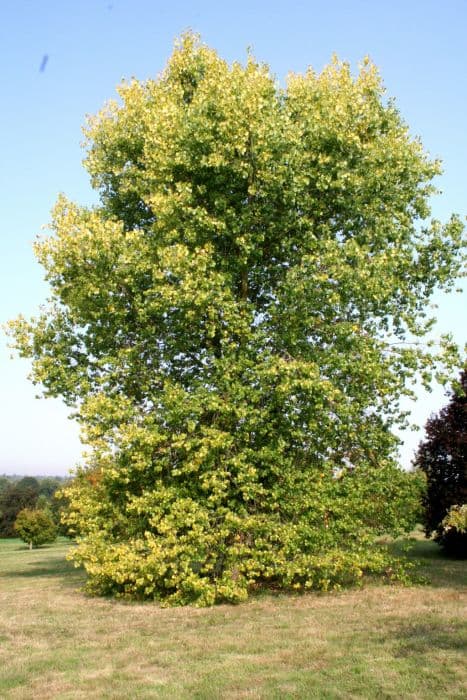Bay Willow Salix pentandra

ABOUT
Salix pentandra, also commonly known as the bay willow, is a plant distinguished by its shiny, dark green leaves that exude a fragrant aroma reminiscent of bay leaves. The leaves are lance-shaped with finely serrated margins and a glossy, almost leathery texture. Bay willow produces catkins, which are spike-like clusters of flowers with no petals. These catkins appear in late spring and early summer. The male catkins are typically yellow due to the presence of pollen, while the female catkins are greener and will eventually develop into small capsules containing the seeds. Bay willow is also recognized for its attractive bark which is smooth and gray when the plant is young but gradually develops deep furrows with age. The branches are often flexible and have a yellowish or brownish tint. Overall, bay willow presents a lush, dense canopy of foliage that can provide a rich, verdant appearance in the landscape.
About this plant
 Names
NamesFamily
Salicaceae
Synonyms
Bay Willow, Laurel Willow, Bay-Leaved Willow, Shiny Willow, European Willow
Common names
Salix pentandra var. pentandra, Salix fragilis var. pentandra.
 Toxicity
ToxicityTo humans
Bay willow, which is the most common common name for Salix pentandra, is not generally considered toxic to humans. The ingestion of parts of this plant typically does not result in poisoning and significant symptoms are not common. Salix species, in general, have been used medicinally and contain salicin, which is related to aspirin, but the use of bay willow specifically for such purposes is less well documented. As with any plant, individual allergies or sensitivities might exist, and consuming parts of the plant not typically meant for ingestion, such as wood or bark, might cause mild stomach upset, but significant toxicity or severe consequences are not commonly associated with this species.
To pets
Bay willow is also not generally known to be toxic to pets such as dogs and cats. Similar to humans, ingestion of parts of Salix pentandra is unlikely to cause significant poisoning in household pets. Some animals might experience mild gastrointestinal upset if they consume large quantities of leaves, stems, or bark due to the fibrous plant material rather than specific toxic compounds. Nevertheless, it's always prudent to monitor your pets around plants and discourage them from chewing on any that aren't explicitly safe, as individual animals could have unique reactions.
 Characteristics
CharacteristicsLife cycle
Perennials
Foliage type
Deciduous
Color of leaves
Green
Flower color
Yellow
Height
33 feet (10 meters)
Spread
26 feet (8 meters)
Plant type
Tree
Hardiness zones
4
Native area
Europe
Benefits
 General Benefits
General Benefits- Wildlife Habitat: Provides shelter and nesting sites for various bird species.
- Landscape Ornamentation: Its glossy leaves and catkins add aesthetic value to gardens and parks.
- Erosion Control: The robust root system stabilizes riverbanks and helps to prevent soil erosion.
- Craft Material: Flexible twigs are used in basketry and other traditional crafts.
- Windbreak: Acts as a protective barrier against strong winds when planted in rows or hedges.
- Shade: Offers a cool, shaded area during hot seasons due to its dense foliage.
- Soil Improvement: Drops leaves that decompose to enrich soil with organic matter.
- Biodiversity: Supports an ecosystem by providing a variety of microhabitats for insects and other organisms.
- Sound Barrier: Dense branches and foliage can help reduce noise pollution.
- Seasonal Interest: Displays an attractive change in leaf color during autumn.
 Medical Properties
Medical Properties- Anti-inflammatory: Salix pentandra contains salicin, which is metabolized into salicylic acid, a compound known for its anti-inflammatory and pain-relieving properties.
- Analgesic: Due to the presence of salicin, which is similar to aspirin, it has been used to alleviate pain such as headaches and other minor aches and pains.
- Antipyretic: The salicin in Salix pentandra may also help reduce fever, as it can act similarly to aspirin in its fever-reducing effects.
- Antirheumatic: It may have uses in treating rheumatic pain, given its anti-inflammatory and pain-relieving qualities.
 Air-purifying Qualities
Air-purifying QualitiesThis plant is not specifically known for air purifying qualities.
 Other Uses
Other Uses- Bay Willow, or Salix pentandra, is often used in basketry due to its flexible branches which can be weaved into various forms.
- Its wood can be utilized in the creation of cricket bats, thanks to its strength and resilience.
- The plant can also serve as a natural dye, providing hues for textiles and crafts through the tannin in its bark.
- Bay Willow's twigs and branches can be fashioned into rustic furniture and garden structures, providing a sustainable material with a natural aesthetic.
- The plant is traditionally used in Europe for thatching roofs, taking advantage of its water-resistant properties.
- Salix pentandra can be made into charcoal, which is often used by artists for sketching and drawing.
- Its dense and attractive foliage can be utilized in landscape gardening for designing hedge rows or screening.
- Bay Willow wood is sometimes used in the manufacture of smaller wooden objects like spoons, cutting boards, or sculptures.
- The bark of Bay Willow can be used in tanning leather, adding a source of tannin that aids in the preservation of animal hides.
- Its inner bark fibers, when processed, can create a type of fabric or paper product through traditional crafting techniques.
Interesting Facts
 Feng Shui
Feng ShuiThe Bay Willow is not used in Feng Shui practice.
 Zodiac Sign Compitability
Zodiac Sign CompitabilityThe Bay Willow is not used in astrology practice.
 Plant Symbolism
Plant Symbolism- Flexibility: The Salix pentandra, commonly known as Bay Willow, is known for its supple branches, which bend without breaking. This symbolizes the capacity to adapt to life's challenges without losing integrity.
- Healing: Historically, willows have been associated with healing because of the salicylic acid found in their bark, an ingredient used to make aspirin. This signifies the plant's connection to healing both physical and emotional ailments.
- Growth: Bay Willow's vigorous growth represents the ability to thrive and expand, symbolizing personal growth and development over time.
- Protection: In some cultures, willow trees are believed to hold protective qualities, providing shelter and safety, which is why they might be planted around homes.
- Mourning: The drooping aspect of some willow species has led to their association with sorrow and mourning, reflecting an individual's expression of grief and sympathy.
- Resilience: Willows can grow in challenging conditions and regenerate from damaged states, representing resilience and the capability to recover from adversity.
- Inspiration: The whispering sound of wind through willow leaves is often thought to inspire poets and artists, linking the plant to creative inspiration and the muse.
 Water
WaterThe Bay Willow, commonly known as Salix pentandra, thrives in moist conditions and requires regular watering. To keep the soil consistently moist, water the plant with about 1 gallon of water once or twice a week during dry periods. During the growing season, particularly in hot summer months, you might need to water the plant more frequently to maintain soil moisture. In contrast, during the dormant winter season, reduce watering to when the soil feels dry to the touch to avoid waterlogging. Always check the top few inches of soil for dryness before watering.
 Light
LightThe Bay Willow does best in full sunlight where it can receive at least six hours of direct sunlight daily. An ideal spot would be an open area away from taller structures or trees that might create significant shade. However, it can tolerate partial shade, particularly in hotter climates where some relief from the intense afternoon sun can be beneficial.
 Temperature
TemperatureFor the Bay Willow, the ideal temperature range is between 35°F and 75°F. The plant can survive in temperatures as low as -30°F and as high as 90°F, but extreme temperatures may stress the tree. This hardy species is adaptable to a wide range of climate conditions but performs best when conditions are within the aforementioned ideal range.
 Pruning
PruningPruning the Bay Willow is primarily done to maintain shape, remove damaged limbs, and encourage healthy growth. The best time to prune is late winter to early spring, before new growth begins. Aim to thin out overcrowded branches and remove any dead or diseased wood annually. Severe pruning should be spaced out over multiple years to avoid stressing the tree.
 Cleaning
CleaningAs needed
 Soil
SoilBay willow thrives in moist, well-drained loamy soil with a pH between 5.5 and 8.0. A mix of garden soil, peat, and sand in equal parts is ideal to ensure proper drainage and fertility.
 Repotting
RepottingBay willow, being a large tree, is not commonly repotted. It's typically planted directly in the ground where it has space to grow. If grown in a container, upgrade to a larger pot when the root system outgrows the current one, which may be every 2-3 years.
 Humidity & Misting
Humidity & MistingBay willow prefers high humidity levels but is adaptable to a variety of humidity conditions typical of outdoor environments. Aim for 50-70% relative humidity if grown in a controlled indoor setting.
 Suitable locations
Suitable locationsIndoor
Grow Bay willow in large containers with ample light and water.
Outdoor
Plant in moist, well-drained soil; full sun to partial shade.
Hardiness zone
4-8 USDA
 Life cycle
Life cycleSalix pentandra, commonly known as bay willow, begins its life cycle when its tiny seeds, which are dispersed by wind or water, germinate in moist soil during spring. The seedlings go through a juvenile phase, developing a root system and a stem while leaves start to photosynthesize to provide energy for growth. As the plant matures, it enters the vegetative growth stage, forming a shrubby or treelike structure with glossy, lance-shaped leaves. Bay willow is dioecious, meaning individual plants are either male or female; it reaches reproductive maturity after several years, producing catkins (flowers) in late spring which are pollinated by insects. After pollination, the female catkins develop into tiny capsules that release seeds, completing the reproductive cycle. The bay willow, being a perennial, can live for many years, continually growing and producing new seeds annually.
 Propogation
PropogationPropogation time
Spring
The Salix pentandra, commonly known as Bay Willow, is often propagated through hardwood cuttings. This method is popular for its simplicity and effectiveness. For optimal results, the cuttings are usually taken during the plant's dormant season, which is late fall or winter. Branches of Bay Willow are selected—preferably those that are about one year old and have reached a diameter of roughly 1/4 to 1/2 inch (approximately 6 to 12 mm). Cuttings about 6 to 8 inches (15 to 20 cm) in length are then snipped off and planted directly into moist soil where they will readily root. It is crucial to keep the soil consistently moist until the cuttings develop strong root systems and start to show new growth, indicating successful propagation.









